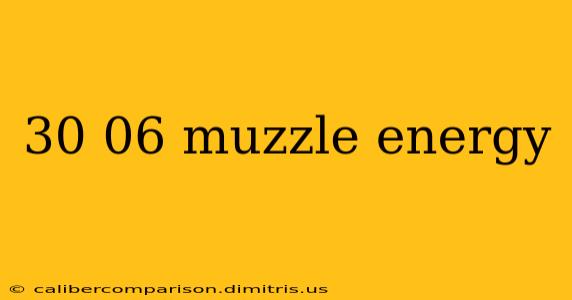The .30-06 Springfield cartridge, a legendary round with a rich history, continues to be a favorite among hunters and shooters alike. One of its most frequently discussed characteristics is its substantial muzzle energy. But what exactly is muzzle energy, and how does the .30-06 stack up against other calibers? This in-depth analysis will explore the factors influencing .30-06 muzzle energy, its practical implications, and provide you with a clearer understanding of this powerful cartridge.
Understanding Muzzle Energy
Muzzle energy, simply put, is the kinetic energy a bullet possesses the moment it leaves the gun barrel. This energy is a crucial factor in determining a cartridge's effectiveness for hunting, target shooting, and other applications. It's calculated using the following formula:
KE = 1/2 * mv²
Where:
- KE = Kinetic Energy (measured in foot-pounds or Joules)
- m = Mass of the bullet (measured in grains or kilograms)
- v = Velocity of the bullet (measured in feet per second or meters per second)
As you can see, both bullet weight and velocity significantly impact muzzle energy. A heavier bullet traveling at the same speed will have more energy than a lighter bullet, and conversely, a faster bullet will have more energy than a slower one of the same weight.
Factors Affecting .30-06 Muzzle Energy
Several factors influence the muzzle energy of a .30-06 Springfield cartridge:
1. Bullet Weight:
Heavier bullets, such as 180-grain or 220-grain projectiles, possess more muzzle energy than lighter bullets, such as 150-grain or 165-grain rounds. This is because the increased mass directly contributes to higher kinetic energy at a given velocity.
2. Powder Charge:
The amount of propellant (gunpowder) used significantly affects bullet velocity. A larger powder charge will generally result in higher velocity and consequently, higher muzzle energy. However, excessive powder can lead to increased pressure, potentially damaging the firearm.
3. Barrel Length:
Longer barrels allow for more complete powder combustion, leading to higher velocities and increased muzzle energy. Shorter barrels, while offering improved maneuverability, generally produce lower muzzle energy.
4. Rifle and Ammunition Manufacturer:
Variations exist in barrel manufacturing tolerances and ammunition specifications, leading to minor differences in muzzle energy even with identical bullet weight and powder charges. Slight variations in rifling twist rate can also play a role.
Typical Muzzle Energy of the .30-06 Springfield
The .30-06 Springfield produces a wide range of muzzle energies depending on the factors listed above. However, a common range for typical hunting loads falls between 2,800 and 3,500 foot-pounds (ft-lbs). This substantial energy makes it effective on a wide variety of game animals, from deer to elk. Specific muzzle energy can be found on the ammunition packaging, usually expressed in ft-lbs.
Muzzle Energy vs. Downrange Energy
It's crucial to understand that muzzle energy represents the energy at the beginning of the bullet's flight. As the bullet travels, air resistance (drag) significantly reduces its velocity and, consequently, its energy. Downrange energy, the energy the bullet retains at a specific distance, is a more relevant factor for hunters determining shot placement and effectiveness at longer ranges.
Conclusion
The .30-06 Springfield's high muzzle energy is a testament to its potent design. This characteristic, along with its accuracy and versatility, solidifies its enduring popularity. While muzzle energy is an important consideration, it's only one piece of the puzzle. Factors like bullet construction, trajectory, and shot placement ultimately determine the effectiveness of any cartridge. Understanding these nuances provides a more complete picture of the .30-06 Springfield and its capabilities.

